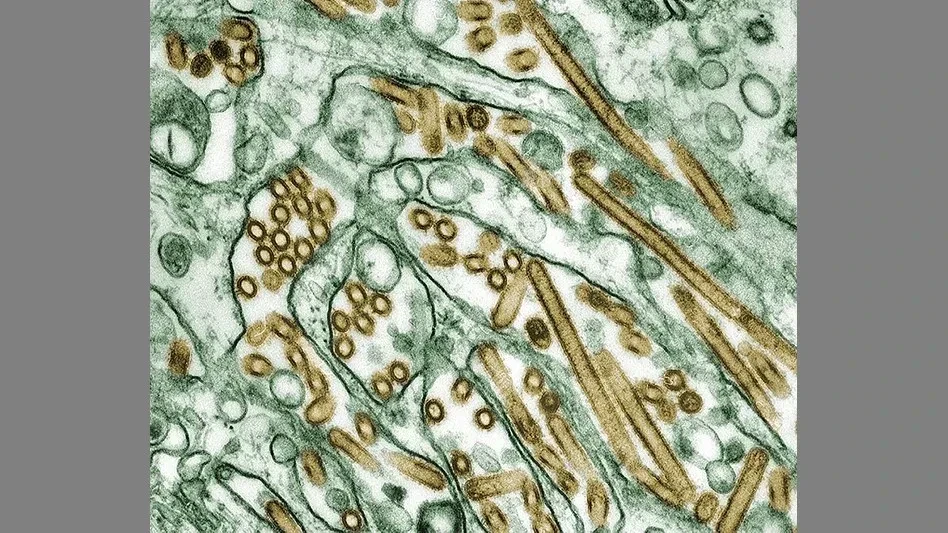When discussing risk assessment for food safety, the first thing that comes to mind for many in the industry are the Hazard Analysis and Critical Control Point (HACCP) principles. While HACCP is a critical component, assessing and managing the safety of food through the chain of supply and within individual plants involves more than just following regulations and guidelines.
THE BIG PICTURE. In 1996, the Joint Institute for Food Safety and Applied Nutrition (JIFSAN) was established between the Food and Drug Administration (FDA) and the University of Maryland (UM), with a mission to provide a scientific basis for food safety and promote food safety and human nutrition and animal health and production through an integrated academic and regulatory science program of research, outreach, education and policy studies.
Among the top research programs of JIFSAN is that of risk analysis. Past Director Dr. David Lineback describes the institute’s industry-wide analysis initiatives as incorporating three parts:
* Risk Assessment. The first step in analysis is identifying the hazard, Lineback says. Using a common occurrence, Lineback explains the difference between risk and hazard: When you’re going to cross the street, he says, the hazard is the oncoming cars; the risk is whether you’re going to step out. In the same way, a food safety hazard is E. coli, the risk is the likelihood of it occurring in, say, beef. While the hazard can’t be eliminated, the risk of its occurrence can be controlled. "Risk assessment reduces that likelihood." Risk assessment, Lineback explains, is conducted through scientific and mathematical procedures by which the risk is identified and measured.
* Risk Communication. "How do I communicate to you what the risk is?" Lineback says is the question to be answered in the second step of the research. "The concept of risk is scientifically and mathematically based, but your concept of risk is not; it is based on the outrage factor." For most people, he says, "something you can see has less risk to you than something you can’t see." This explains why consumers tend to be less comfortable with control agents such as irradiation than they are with sprays – something they can see. On the other hand, people will have less fear of a highly infectious epidemic that has not – yet – affected people they know than a non-contagious disease of their neighbor. "The risk of that miniscule," he says, "but if your next door neighbor got it, you’d be worried sick." Thus the challenge is to convey actual risk by eliminating the innate emotion of a situation.
* Risk Management. Once the supply chain risks and hazards are assessed and communicated, those in various levels of "management" need to determine how the risks can be managed. Regulatory agencies, for example, must determine the mandates that should be in place for food safety while each link in the supply chain needs to set its own standards for plant and employee practices as well as supplier standards. For the food processor, this mean establishing your own HACCP plan, based on the risk analysis results for the products being produced; setting standards both within the plant as well as backward and forward in the supply chain and staying up to date on current industry events and research findings.
HACCP PRINCIPLE. The first HACCP principle is conducting a hazard analysis in order to develop a list of those which are reasonably likely to cause injury or illness if not effectively controlled. If the hazard analysis and identification is not properly conducted, "the plan will not be effective regardless of how well it is followed," according to the HACCP Principles and Application Guidelines publication of the National Advisory Committee on Microbiological Criteria for Foods (NACMCF). The process involves:
1. Hazard identification. Through a review of ingredients, process, equipment, final product, storage, distribution, intended use and consumer, the HACCP team develops a list of potential biological, chemical or physical hazards which may be introduced, increased, or controlled at each step in the production process.
2. Hazard evaluation. With the information from step one, the team determines the hazards to be addressed in the HACCP plan, based on the severity of the potential hazard and its likely occurrence.
3. Hazard control measures. Once the analysis is completed, the hazards associated with each step of the process are listed and control measures are identified. NACMCF uses the term "control measures," it says, "because not all hazards can be prevented, but virtually all can be controlled."
ALWAYS STAY CURRENT. When defining hazards and risks, a plant should ensure it is in tune with the times and remains flexible. "Producers are very attune to risk, but that changes all the time; pathogens change," says Tom Ford, vice president of food safety, Ecolab Food Retail. How virile a pathogen is; where and how it may be brought into a plant; how susceptible it is to control measures – all can be vectors of change of which the processor must be aware and have the expertise to identify new risks and set or update appropriate control measures.
For example, Ford says, Listeria wasn’t on the radar screen 15 to 20 years ago, then it became a significant challenge and processors increased their control measures. Today, its incident rate is again lessening, which indicates, he says, "the interventions the producers are taking are effective." However, this does not mean that processors should lessen their efforts toward the pathogen, or this could follow the same path as Salmonella, for which occurrence had been lessening, but is now once again on the rise.
Changes in technologies, tolerances and even consumer trends can affect a plant’s risk assessment. As technology is able to detect smaller and smaller quantities, the tolerance levels are also decreasing, though it is not simply technological capabilities which are driving this as much as awareness, and consumer product choice and non-tolerance – which may be circling back to instigate the drive for technological advances. As the technology gets more advanced, and more tools are introduced, Ford says, plant managers need to ensure they are open-minded and flexible.
The trend toward ready-to-eat products also has had a significant effect on food safety practices. If you are canning corn, Ford uses as an example, the risk factor can be low; but if you are producing ready-to-eat products, such as spinach, the risk is greatly increased, and all aspects of the process – particularly the packaging – need to be assessed for safety.
Ford sees a next major concern for the industry to be Norovirus. While Norovirus can be a foodborne illness, it is of viral rather than bacterial etiology, and it is difficult to detect. At this point, while research is continuing, there is not enough expertise on the virus, including where the risk lies or its potential sources. But steps can be taken toward prevention through basic shoring up the plant’s food safety program and verifying of good personal hygiene by all employees; thorough records on all product and ingredients; and, he says, "identifying how the food can get contaminated and limiting that risk."
SUPPLIER STANDARDS. "Retailers and producers have always had a great, tight relationship," Ford says, but the line of communication doesn’t always seem to be so strong between producers and suppliers. Strengthening this is primarily a matter of increasing communication and setting expectations. "As situations occur, they need to communicate and identify what they need these producers to be identifying, and what they need to do to identify the risks," Ford says. "They need to be just working and communicating both directions. It’s really communication and partnership."
Whether a food processor’s ingredients come straight off the farm or through other distributors or processors, the line of communication should stretch all the way back to the product roots.
"Being positioned in the middle of the field-to-fork supply chain, it is very important that their plant isn’t the conduit for introducing disease from the field to the public," says Robert Larose, president of BioSafe Systems, LLC. The processor should mandate not only that suppliers know how each product was grown but that it meets strict requirements for growth and production. Processors should ask suppliers for information on areas such as:
* Records of any pesticides used (in field and storage) and how often applied.
* On-farm HACCP program and records of compliance.
* Sanitation of water used for crops and disclosure of any water quality issues.
* Sanitation of facilities and sanitation standards.
* Crop storage for food safety and security.
* Pre-shipping crop sanitation
* Transport truck sanitation after each shipment.
* Use of non-porous vs. wooden containers.
These are important because, Larose says, "By the time crops arrive to the food processor, they may already be contaminated, and depending upon conditions, the procedures and methods in place at the processor may not be sufficient to overcome the problem." This would be the case, for example, with any pathogens that have become internalized within the crop. "Field cooling methods such as hydro cooling can, at times, help with the internalization process."
In addition, processors should understand the potential for contamination and know the safety records of products they purchase. "This is not to say that any processor should be complacent about any product purchased," Larose says, "but the crops with past histories should receive a greater degree of scrutiny."
PLANT STANDARDS. Following supplier requirements with in-plant standards and training retain the safety of the products moving through the supply chain. The most important aspects of food safety within a plant, says Tom Huge, president of ASI Food Safety Consultants in St. Louis, Mo., are record-keeping and employee training. Maintaining documentation on such areas as pest control, batch records, quality records are all critically important to maintaining food safety and tracking of any problems which do arise. Running periodic mock recalls can help a plant assess it documentation and ensure that all tracking and traceability requirements and standards are in place. "A lot of big food manufacturers don’t have a recall program and don’t know how to do a mock recall," Huge says. The industry is moving forward in this area, but it should have emphasis in every plant.
And it is industry knowledge sharing and communication, as is conducted in food safety summits and conferences, that is most critical to moving the efforts forward. "Food safety is not a competitive edge," Ford says. "It’s a common concern for everyone." QA
The author is a contributing editor to QA magazine.

Explore the March 2007 Issue
Check out more from this issue and find your next story to read.
Latest from Quality Assurance & Food Safety
- Nestlé Opens Arizona Beverage Factory and Distribution Center
- Ingredion Invests $100 Million in Indianapolis Plant to Improve Efficiency, Enable Texture Solutions Growth
- Eagle Unveils Redesigned Pipeline X-ray System
- USDA Invests Up To $1 Billion to Combat Avian Flu, Reduce Egg Prices
- Washington Cats Confirmed with HPAI as Investigation into Contaminated Pet Food Continues
- USDA Confirms Bird Flu Detected in Rats in Riverside
- Kyle Diamantas Named FDA’s Acting Deputy Commissioner for Human Foods
- QA Exclusive: Food Safety Leaders React to Jim Jones’ Departure, FDA Layoffs





